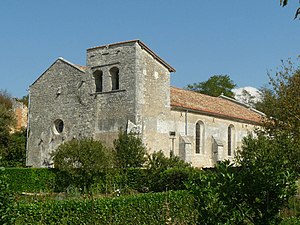Pranzac
| Pranzac | ||
|---|---|---|
|
|
||
| region | Nouvelle-Aquitaine | |
| Department | Charente | |
| Arrondissement | Angoulême | |
| Canton | Val de Tardoire | |
| Community association | La Rochefoucauld-Porte du Périgord | |
| Coordinates | 45 ° 40 ′ N , 0 ° 21 ′ E | |
| height | 80-131 m | |
| surface | 15.06 km 2 | |
| Residents | 903 (January 1, 2017) | |
| Population density | 60 inhabitants / km 2 | |
| Post Code | 16110 | |
| INSEE code | 16269 | |
 Pranzac - Saint-Cybard Church |
||
Pranzac is a southwestern French community with 903 inhabitants (at January 1, 2017) in the Charente in the region Nouvelle-Aquitaine .
location
The place, created from several small hamlets ( hameaux ), is about 18 kilometers (driving distance) east of Angoulême and about nine kilometers south of La Rochefoucauld .
Population development
| year | 1968 | 1975 | 1982 | 1990 | 1999 | 2007 | 2012 |
| Residents | 629 | 667 | 790 | 874 | 792 | 888 | 920 |
At the first census in France in 1793, the place had 617 inhabitants; thereafter the population remained more or less stable.
economy
Pranzac and the smaller communities in the area live mainly from agriculture and viticulture. The place still belongs to the area of the Bons Bois in the far east of the Cognac wine-growing region . Since the 1970s, the rental of holiday apartments ( gîtes ) has been an important source of income for the place.
history
Little information is available about the history of Pranzac: The present-day location is near the old Roman road from Angoulême ( Ecolisma ) to Limoges ( Augustoritum ); settlement has been proven for the Gallo-Roman period. The belonging to the church today Weiler Luget was in the Middle Ages in the possession of the Cistercian - Notre-Dame de Grosbois who built a chapel here in 1121, which was only a little later expanded into a priory, which, however, only a short time inventory had .
Attractions
- The originally single-nave Romanesque church (formerly collegiate church) Saint-Cybard stands on the eastern edge of the municipality. Essentially, it comes from the 12th century; In the 16th century it received a chapel extension on the south side - donated by the landlady at the time, a lady of the car . The west facade is completely unadorned; the interior of the church has a barrel vault with belt arch beams and impresses with its harmonious proportions; the choir has a straight ending. As with many churches in southwest France, the installation of windows was largely dispensed with for reasons of cost and defense. The burial chapel of the castle lady, which was added later, has large, bright windows and is covered by a ribbed vault. The church building was added to the list of Monuments historiques in 1938 . A panel of St. Cybard dressed as a bishop from 1810 and an iron paten from the 14th century have also been classified as monuments historiques .
- Another attraction of the place is the death lantern ( lanterne des morts ) which is about 200 meters west of the church ; it probably originally stood in the municipality's former cemetery, which was later relocated. It was also built in the 12th century and consists of a multi-stepped round base zone, a - standing on a base - about 4.20 meters high round shaft and a conical tip with a cross. Through a large opening on the side of the hollow shaft, lights could be lifted up into the air using a ladder, poles or a rope pull. It is unclear whether it was a so-called ' Eternal Light ' or whether lights were only lit on certain days of the year ( All Saints' Day , All Souls Day , funeral and memorial days , etc.). The death lantern was recognized as a monument historique as early as 1905 .
- The remains of the castle ( Château des Comtes des Cars or d'Escars ) from the 15th century, which was built from largely uncut stones, are badly neglected or in parts completely crumbled. The preserved semicircular stair tower on the side closes with a wreath of machicolations , above each of which there is a fan-shaped decorative element; above it runs a battlement with window openings. The residential building ( corps de logis ) shows - like the tower - rectangular windows made of precisely hewn stones.
See also
Personalities
- Jacques Roux (1752–1794), priest and revolutionary
- Jean Audiat (1903–1991), classical archaeologist and Graecist
Individual evidence
- ↑ Église, Pranzac in the Base Mérimée of the French Ministry of Culture (French)
- ↑ Tableau St-Cybard, Pranzac in Base Palissy of the French Ministry of Culture (French)
- ↑ Fer à hosties, Pranzac in the Base Palissy of the French Ministry of Culture (French)
- ↑ Lanterne des morts, Pranzac in the Base Mérimée of the French Ministry of Culture (French)



